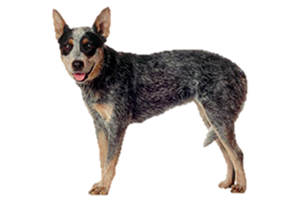Australian Cattle Dog
Australian Heeler, Blue Heeler, Heeler, Queensland Heeler, Red Heeler

The Australian Cattle Dog is a herding breed that was developed for driving and controlling cattle by nipping at their heels. However, they can be used with other livestock such as horses and goats. They are silent workers, a trait gained from their Dingo ancestry, which helps prevent panic in the herd. Today they remain extremely popular with farmers and ranchers worldwide.
Australian Cattle Dog Standards
- 17-20"
- 35-45 lbs
- medium-sized herder
- moderate, pricked ears
- tail approximately reaches hock
- straight, hard, flat double coat
- blue
- blue mottled
- blue speckled
- red speckled
History of the Australian Cattle Dog
The development of the Australian Cattle Dog is somewhat debated. It is generally accepted that their primary ancestor is the now extinct Hall’s Heeler. Thomas Hall created these dogs to replace the European herders that accompanied livestock when it was transported to Australia. These traditional dogs did not adapt well to the Australian climate and lacked the stamina Hall desired to drive his cattle across the continent.
The history of the modern Australian Cattle Dog begins in 1870 when Thomas Hall passed away. Due to business reasons he had rarely allowed others to obtain his heelers outside of family and close friends. As his estate was settled, his dogs were purchased by other ranchers.
From 1870 to 1890 various other breeds were added to the bloodline. It is believed the Dalmatian, Bull Terrier (which was seen as a failure), and what would become the Kelpie were all part of this mixture. Along this same time they became known as Blue and Red Heelers based on coat, which is common even today. The Blue Heelers were favored as some thought the Red contained more Dingo blood.
In 1890s fanciers formed the Cattle Dog Club. Originally they included all stock dogs, but then primarily focused on the descendants of the Hall’s Heeler. They gave the breed its modern name and helped fix its type, which was first done in 1893.
Related Breeds:
